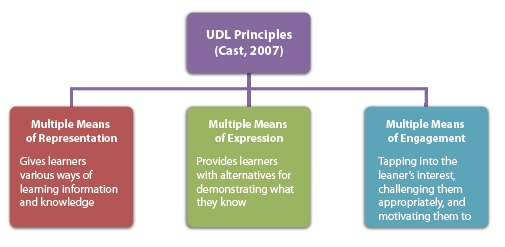Authors: Gabrielle Rappolt-Schlichtmann, Marianne Bakia, Jose Blackorby, David Rose
Printer-Friendly PDF | Questions? Contact CIRCLS
- Overview
- Issues
- Projects
- Resources
- Readings
- Citation
Overview
Overview
Universal Design for Learning (UDL) is a research-based framework intended to guide the design of learning technologies that are accessible and effective for all students, including those who are struggling academically and those with special needs. Inspired by the concept of universal design in architecture, the framework was first conceived in the early 1990s and developed over the intervening decades. UDL has entered the public consciousness as many local, state, national and international education settings have moved to adopt the framework. For example, UDL has influenced the design of more accessible museum exhibits and usable K12 curricula for low-vision/blind students. The Higher Education Opportunity Act (HEOA) of 2008 established the statutory definition for UDL, emphasizing that pre-service teacher training incorporate instruction on strategies consistent with UDL. More recently, the U.S. Department of Education’s National Educational Technology Plans (2010 and 2015 in preparation), which is meant to guide the use of technologies in transforming education, refers to UDL as a framework that reduces barriers and maximizes learning opportunities for all students.
This attention to UDL within the field of education reflects and leads a broader conceptual shift away from “one size fits all” solutions and toward greater interest in providing “personalized” learning experiences for everyone. The UDL approach takes human diversity as its starting point rather than as an unexpected complication that will later require expensive modification or accommodation. Moreover, by attending early to the challenges of people who may be “in the margins” because they may have a different set of abilities, the UDL approach provides a foundation for educational designs that are powerful and flexible enough to optimize outcomes for all learners.
The theory and practices of UDL depend upon advances in two domains: modern learning sciences and modern learning technologies. From the learning sciences – cognitive neuroscience, affective neuroscience, cognitive science, educational sciences – UDL draws upon research that articulates the consequential differences between learners, differences that must be addressed for a learning technology to be successful for the full spectrum of learners. From modern learning technologies – such as interactive multimedia and networked learning environments – UDL takes advantage of the enormous capacity for personalization and adaptivity that these new technologies offer but that is usually insufficiently realized.
Just as universally designed buildings provide options that accommodate a broad spectrum of users, tools and curricula that are designed using the UDL framework offer a range of options for accessing and engaging with learning materials. The UDL principles can be applied to design of curricula, instructional practices, and assessments and the following three principles (along with actionable guidelines) address challenges that must be addressed to reach all students, and that can be addressed with modern learning technologies: (1) providing multiple means of presentation (e.g., perception, language, comprehension), (2) providing multiple means of action and response (e.g., action, expression, communication), and (3) providing multiple means of engagement (e.g., interest, persistence, self-regulation). UDL offers a means to provide opportunities for flexible and deep learning through the design of customizable methods, materials, and assessments (Meyer, Rose, & Gordon, 2014; Rose & Meyer 2002; Rose, Meyer, & Hitchcock, 2005).

In the design process, UDL requires close attention to learners with “disabilities” — the framework posits that these students are “canaries in the coal mine” that can alert designers and educators to problems and barriers in their methods, materials and assessments. When people with disabilities experience difficulty in an educational environment, it is often a sign that others without disabilities may also have difficulty, though it may be less readily apparent. By attending to the challenges faced by individuals in the margins early in the design process, learning environments can be made more accessible, engaging and effective for a wider array of students. Taking this approach results in a profound change in thinking that moves away from the “child as a problem” perspectives that have dominated our view of human diversity (see Dudley-Marling 2004; Albrecht, Seelman, and Bury 2001) and toward social constructivist views of education that recognize that the barriers and limitations of poor design in the environment are the critical problem to address in a democratic society. In this modern, universal design view, it is the “disabilities” and “handicaps” of our learning technologies that must be the first focus of intervention (see Rappolt-Schlichtmann & Daley, 2013; Thaper et al. 2004).
The research base for UDL in practice is growing, with contributions from a wide range of organizations and professionals and includes descriptive, correlational, and experimental studies. A recent review of the research literature suggests that UDL has made significant inroads into a number of educational communities, as measured by journal spread, intended audience, disability categories (including those with no disabilities), describing work affecting students with a wide age range, from early childhood through adulthood (Okolo and Diedrich, 2015). Studies of efficacy have been fewer, but are beginning to provide evidence of the frameworks value in the design of educational tools and environments at scale (for example, see Rappolt-Schlichtmann, et al., 2013 for efficacy trial of UDL science notebook). Further design-based research is needed to explore the many potential approaches (and innovations) to the instantiation of UDL in technology based STEM learning solutions, as well as implementation research that explores and validates the use of UDL approaches in authentic STEM learning settings.
